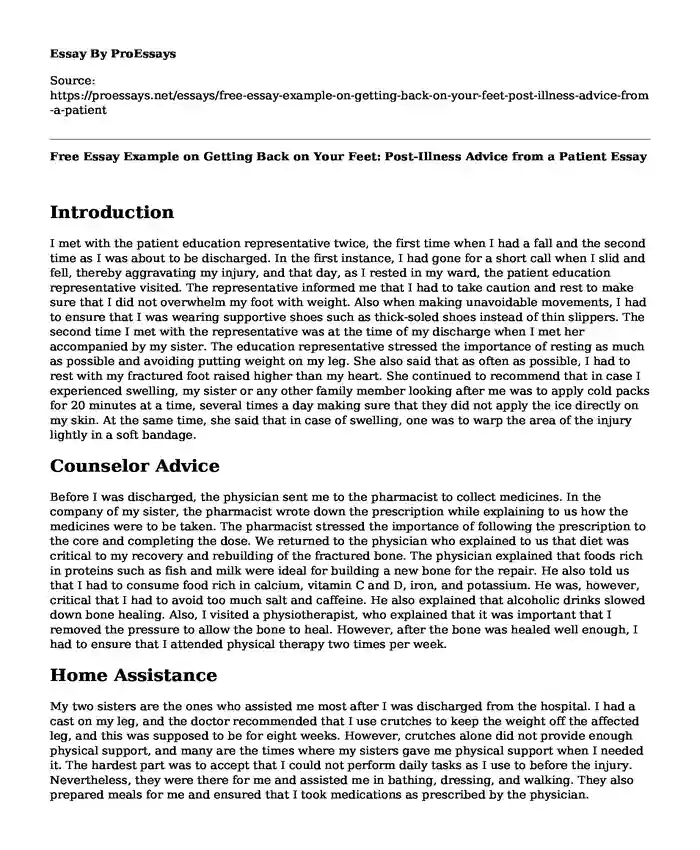Introduction
I met with the patient education representative twice, the first time when I had a fall and the second time as I was about to be discharged. In the first instance, I had gone for a short call when I slid and fell, thereby aggravating my injury, and that day, as I rested in my ward, the patient education representative visited. The representative informed me that I had to take caution and rest to make sure that I did not overwhelm my foot with weight. Also when making unavoidable movements, I had to ensure that I was wearing supportive shoes such as thick-soled shoes instead of thin slippers. The second time I met with the representative was at the time of my discharge when I met her accompanied by my sister. The education representative stressed the importance of resting as much as possible and avoiding putting weight on my leg. She also said that as often as possible, I had to rest with my fractured foot raised higher than my heart. She continued to recommend that in case I experienced swelling, my sister or any other family member looking after me was to apply cold packs for 20 minutes at a time, several times a day making sure that they did not apply the ice directly on my skin. At the same time, she said that in case of swelling, one was to warp the area of the injury lightly in a soft bandage.
Counselor Advice
Before I was discharged, the physician sent me to the pharmacist to collect medicines. In the company of my sister, the pharmacist wrote down the prescription while explaining to us how the medicines were to be taken. The pharmacist stressed the importance of following the prescription to the core and completing the dose. We returned to the physician who explained to us that diet was critical to my recovery and rebuilding of the fractured bone. The physician explained that foods rich in proteins such as fish and milk were ideal for building a new bone for the repair. He also told us that I had to consume food rich in calcium, vitamin C and D, iron, and potassium. He was, however, critical that I had to avoid too much salt and caffeine. He also explained that alcoholic drinks slowed down bone healing. Also, I visited a physiotherapist, who explained that it was important that I removed the pressure to allow the bone to heal. However, after the bone was healed well enough, I had to ensure that I attended physical therapy two times per week.
Home Assistance
My two sisters are the ones who assisted me most after I was discharged from the hospital. I had a cast on my leg, and the doctor recommended that I use crutches to keep the weight off the affected leg, and this was supposed to be for eight weeks. However, crutches alone did not provide enough physical support, and many are the times where my sisters gave me physical support when I needed it. The hardest part was to accept that I could not perform daily tasks as I use to before the injury. Nevertheless, they were there for me and assisted me in bathing, dressing, and walking. They also prepared meals for me and ensured that I took medications as prescribed by the physician.
I understand that as I get old, it will reach a point where I will need assistance so that I stay in my home. I know that the National Association of Area Agencies on Aging (n4a) and the National Council on Aging (NCOA) can give me assistance services that will help me stay in my home as I get old. These two will give me private and public information to keep me aware of the many available forms of assistance, including food, transport, and healthcare. The National Council on Aging helps aging people with the mission of improving the lives of millions of older adults. I already have the contact of these organizations, and I desire to contact them when the right time comes.
Conclusion
From the above, it is clear that the patient achieved positive health outcomes because of adhering to instructions given at the hospital. Usually, patient adherence to instructions is a result of effective patient teaching (Falvo, 2011). It is a phenomenon that is depicted in this patient in terms of how he was taught to conduct himself in day to day activities, what to eat, and how to exercise. Even the healthcare professionals in this hospital understand that positive patient outcomes are only achievable if patient-centered teaching is a core policy in the institution.
Reference
Falvo, D., R. (2011). Effective patient education (4th ed.). Sudbury (Massachusetts): Jones and Bartlett.
Cite this page
Free Essay Example on Getting Back on Your Feet: Post-Illness Advice from a Patient. (2023, Oct 13). Retrieved from https://proessays.net/essays/free-essay-example-on-getting-back-on-your-feet-post-illness-advice-from-a-patient
If you are the original author of this essay and no longer wish to have it published on the ProEssays website, please click below to request its removal:
- Distinguishing Science From Pseudoscience Paper Example
- Descriptive Essay of My Mother
- Essay Sample on Anthropometry and Body Composition
- Prenatal Drug Abuse: Prosecuting Women for Substance Use - Essay Sample
- Paper Example on MSN Family Nurse Practitioner: Delivering Family-Focused Care
- Paper Example on Lower Health Care Costs: A Necessity for Family Wellbeing
- Free Essay Example on Improve Your Nursing Practice with Evidence-Based Practices







